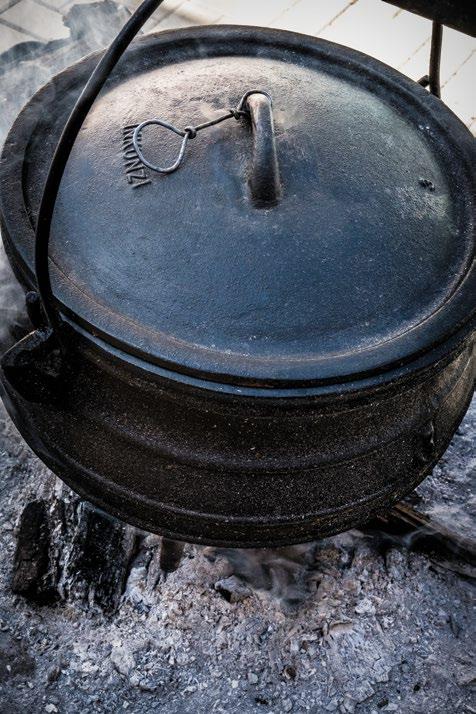
2 minute read
Potjie
It is quite common for dishes to be named after the vessel that is used for cooking them. Paella, tagine, cataplana and nabemono are examples of such dishes. Nabemono is a Japanese dish and refers to ‘all things cooked in a nabe’ (pot). This includes a high-calorie one-pot dish popular among Sumo wrestlers and therefore called chanko nabe (Sumo stew). Our potjiekos is another such dish. But it goes even further: in addition to being a cooking vessel (potjie) and a dish (potjiekos), potjie also refers to the social event of gathering to cook the dish (let’s have a potjie).
The use of the English word ‘pot’ dates back to about 1180, but the use of cast iron cookware is much older. The Dutch dish “hutspot” is the direct ancestor of our potjiekos. Hutspot originated in the 1566-1648 war between Spain and the Netherlands. During the Siege of Leyden and the resultant food shortage, people contributed food to be cooked in large communal pots. Hutspot is still cooked to this day to commemorate the Siege of Leyden.

Not long after the invention of the hutspot, Jan van Riebeeck set sail for the Far East and reached the Cape of Good Hope in April of 1652. These early European settlers brought the cast iron potjie (and also the hutspot stew) with them.
The original potjies were hung from hooks over open fires and were small enough to be taken on trips inland to explore the fledgeling Cape Colony. The indigenous population came into contact with the cast iron pot and it soon replaced the traditional clay pots. The potjie was ideal for the outdoor over open fire cooking style of the frontier culture where cookware had to be strong and durable enough to survive the long rough journeys.
Historical evidence shows that the potjie has been present among the local Nama population since at least 1808. It arrived here with the Orlam commandos who moved into southern Namibia around that time. The Nama often stewed their meat in milk as they had no shortage of it due to their abundance of cattle.

Potjies come in different sizes and each size bears a unique number. For a rough estimate of how many people the content of a pot will feed, it is suggested that the size of the potjie (e.g. 3 or 4) is multiplied with the number of rings on the pot.
Tough cuts of meat were traditionally used for potjies, but really anything goes: chicken, fish or vegetarian potjies are not uncommon. A typical meat pot is assembled in layers. First, the protein is seared, then seasoned with aromatics such as garlic and onions and spices. A little liquid is added, before the next layer is added – usually the firm vegetables that take the longest time to cook. The final layer of softer vegetables that require much less cooking is put on top (often at a later stage) before the lid is closed and the food is left to simmer and steam until it is done.
Christie Keulder










